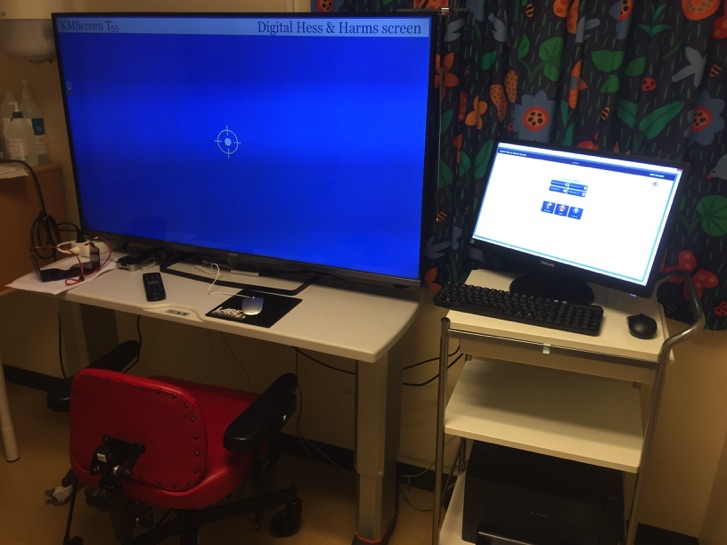(1)
Does the patient need a chin rest? Usually, Hess/Lees Screen require a chin rest so that the eyes of the patient are centered and in the primary position.
According to our experience, it was quicker to examine the patient without the chin rest and the majority of patients also preferred having the examination without it. At our installations, and in order to center the patient's eye to the center of the screen, we recommend our clients to obtain either an electric height-adjustable table and/or a height-adjustable chair. In our clinical evaluation, we found no difference in the results between the group that used the chin rest and the group without a chin rest. But we sell a chin rest as an option for customers who want it.
(2) Can the TV screen be placed on the wall instead of the table in order to save space? This should be possible as long as the testing distance is 50 cm.
Yes, it is possible to mount the TV on the wall with a VESA standard wall mount.
During the examination, the patient can use the mouse to locate and click on the different fixation targets on the screen.
We will need either a small table/shelf for the mouse in front of the TV. If there is no space at the examination room, we can mount a small folding shelf. Alternatively, the patient can have a laptop support or a flat wooden tray on his/her lap in order to use the mouse.
(3) The outer field for the TV screen is only 25 degrees, while Hess test measures up to 30 degrees. How accurate would the test results be?
Hess screen should be seen as one of several tests for diagnosing, documenting, and following up various disorders of binocular vision.
For instance, we cannot decide on a strabismus surgery based on the results of a Hess screen test only. You have to add such measurements as prism cover test at different distances.
However, according to our experience 25 degrees is equivalent to 30 degrees when diagnosing and monitoring the overactivity and deficiency in ocular muscles. It should be noted that certain patients require the examination of 30 degrees.
At the same time, it often happens that we need to skip certain gaze direction during the Lee’s/Hess screen because the patient cannot see the fixation target due to various anatomical obstacles. Sometimes we have to turn the patient's head to make it possible for him/her to see the 30-degree target. That means that this target is rather at 25 degrees and not at 30.
(4) What kind of glasses is required, the Red and Green or Red-Blue Visor? I normally use the red and green. I noted that the targets are red and blue in the picture.
In the KMScreen Preference Settings you can switch between blue-red targets and green-red targets.
The color combination that you choose depends partly on the examination room. For example, if there is a lot of daylight in the room, then the green color is preferable to the blue. This is determined when we calibrate the TV. (This is done only once).
The blue color glasses block out the red color and drop through the green or the blue target, which it is equivalent to the green glasses. But in the case of the TV screen, the light comes from LED or fluorescent lights and we found that the blue plexiglass is then superior to the red-green goggles.
(5) Do I need software other than the four required to plot the Diplopia Chart, Angle of Deviation etc., or are these already inclusive?
The short answer is no, you do not need a separate program.
Hess Screen
Once the patient has gone through all the targets displayed on the screen, we can either continue with diplopia tests in the 9 cardinal directions of gaze or go on to saving and analyzing the results.
Diplopia Test tests both double images and the torsion.
Harms screen
With Harms method, we test both diplopia and torsion simultaneously in the 9 cardinal gaze directions at 25 degrees. The results of the examination are presented both as a traditional Hess chart and deviations angles, which also includes torsion.
There are 3 different programs with the Hess method.
15° and 25° consisting of 25 + 25 viewing targets
25° consisting of 9 + 9 viewing targets and
15° showing 9 + 9 viewing targets in 15 degrees.
The 15 degrees program automatically switches to showing 30 degrees fixation targets if the screen is larger than 55 inches or the test distance is closer than 50cm.
